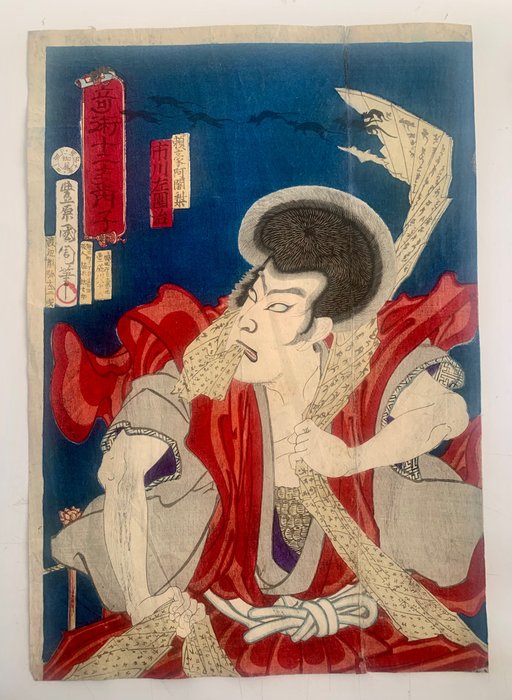
Actor Nakamura Sōjūrō as Hirai Yasumasa 平井保昌 - ca 1870 - Utagawa Ichiyotei Yoshitaki (1841-99) - Japonia - Meiji period (1868-1912)
Nr 81709823

Nr 81709823

This rare print depicts Ichikawa Sadanji as the monk Raigō Ajari from the series 'Magic in the Twelve Signs of the Zodiac'. It was made by Toyohara Kunichika in 1877.
See National Diet Library: https://ndlsearch.ndl.go.jp/books/R100000002-I024121745
Ichikawa Sadanji (1842-1904) as the monk Raigō Ajari (1002-1084) clutches and gnaws at a sutra scroll from which a string of rats emerge. (Yoshitoshi's depiction in 'New Forms of Thirty-Six Ghosts' depicts Raigō himself as having already turned into a rat, a future only hinted at in Kunichika's print.)
THE STORY OF RAIGO AJARI (from the Tale of Heike):
Raigō's prayers have given Emperor Shirakawa (r. 1072-86) an heir, and in return he asks in return for a raised platform, like the one in the temple of the yamabushi (warrior priests) who terrorised Kyoto. When his reward falls through, Raigō starves himself to death and his vengeful spirit (onryō, 怨霊) changes into a thousand rats which destroy the Emperor’s sacred library. The fruit of Raigō's prayers, the emperor's son Atsufumi, dies at age four, having been frequented at his bedside by the spirit of the ominous white-haired old priest.
from THE TALE OF HEIKE (trans. Royall Tyler):
The emperor rejected Raigō's request.
Raigō returned to Miidera bitterly disappointed and prepared to starve to death. Alarmed, His Majesty summoned Oe no Masafusa, then still the governor of Mimasaka.
"I gather that you are one of Raigō's patrons," he said.
"Go to him and try to make him see sense."
Masafusa obediently set off for Raigō's lodge, to speak to him for the emperor.
He found Raigō shut up in a smoke-blackened personal chapel,
whence there issued, in fearsome tones, these words:
"The Son of Heaven does not jest;
his word is to be like sweat.
If my modest wish is to go unmet, then, since my prayers gave the prince life,
I will take him with me into the demon realm."
YOKAI:
Tesso (鉄鼠) is a Japanese yōkai related to the vengeful spirit (onryō) of Raigō and a mouse. The name "tesso" is a name given by Toriyama Sekien in the Edo period collection of yōkai pictures, the Gazu Hyakki Yagyō. This yōkai is also sometimes given the Raigo-derived name Raigō-nezumi (頼豪鼠) as from the Enkyōhon (延慶本, alternatively read Enkeihon), a yomihon version of the Heike Monogatari. Other times it goes by the name Mii-dera-nezumi (三井寺鼠) derived from Mii-dera in Ōtsu, Shiga Prefecture as in the Edo period yōkai themed kyōka picture book, the Kyōka Hyaku Monogatari. Mii-dera is the temple Raigō wanted to glorify by raising a platform for it, but the emperor did not allow this, wary as he was of enhancing its power and position.
https://yokai.com/tesso/
Condition: Print has a fold with a restoration at the bottom of the fold. Dustiness, wrinkling. A small separation of paper at the top white edge of the print. Good colours and dimensions.
Your shipment: Between sturdy cardboard. Track and trace and additional coverage.
Jak kupować w serwisie Catawiki
1. Odkryj coś wyjątkowego
2. Złóż najwyższą ofertę
3. Dokonaj bezpiecznej płatności